Family : Mustelidae

Text © Prof. Giorgio Venturini

English translation by Mario Beltramini
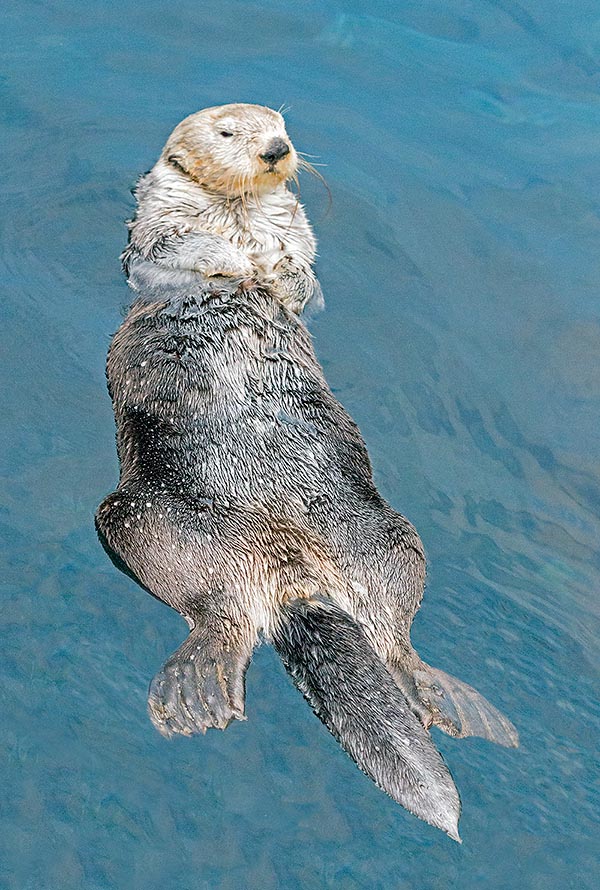
Once common from Japan to Alaska and California the Enhydra lutris is now an endangered species © Giuseppe Mazza
The Sea otter (Enhydra lutris Linneo, 1758) belongs to the family of the Mustelidae and is the only member of the genus Enhydra.
The term Enhydra comes from the Greek “en” (εν) = in and “hydor” (υδορ) = water, therefore, “in the water”, due to its habitat; lutris is the Latin name of the otter.
Zoogeography
In the past this animal occupied a very vast north-Pacific area with a bow going from north of Japan (Hokkaido), through Sakhalin, the Kuril Islands, Kamchatka, Aleutian Islands, southern coast of Alaska and southward up to California, with a very numerous population, of many hundred of thousands of specimens.
The hunting, started by mid of the ‘700 has greatly reduced the number of sea otters that in early ‘900 was reduced probably to only 2000 individuals.
The hunting stop and the conservation policies have had an extraordinary success and presently it is estimated that 100.000 to 150.000 specimens do live gathered in colonies localized mainly in Russia, Alaska, British Columbia, Washington and California, the first two regions being those hosting the greatest number of animals.
The range occupied goes from the 57 degrees North, where the limit is given by the freezing sea, up to the 22 degrees North, limit of the distribution of the forests of kelp, the main habitat of the sea otter.
Three subspecies are accepted, with different geographic distribution: Enhydra lutris lutris (Linneo, 1758) present in Japan, Kuril Islands, Kamchatka Peninsula and Commander Islands, Enhydra lutris kenyoni (Wilson, 1991), from the Aleutian Islands up to Alaska, to Canada and up to Oregon and Enhydra lutris nereis (Merriam, 1904) present in California.
This species must not be mistaken with the other so-called marine otter (Lontra felina), South American mustelid mainly terrestrial that frequents the estuarine habitats.
Ecology-Habitat
The sea otter lives in coastal waters of medium depth (usually, 10-30 m), preferring areas protected from the waves thanks to emerged rocks, coastal barriers and lives especially in the forests of Kelp (Macrocystis pyrifera , laminarias, brown algae).The forests of kelp offer a habitat extremely rich of preys good for the sea otter, invertebrates as well as fishes. The long ribbons of the kelp are also used by the sea otter as anchorage in order to avoid being dragged by the currents while sleeping or feeding.
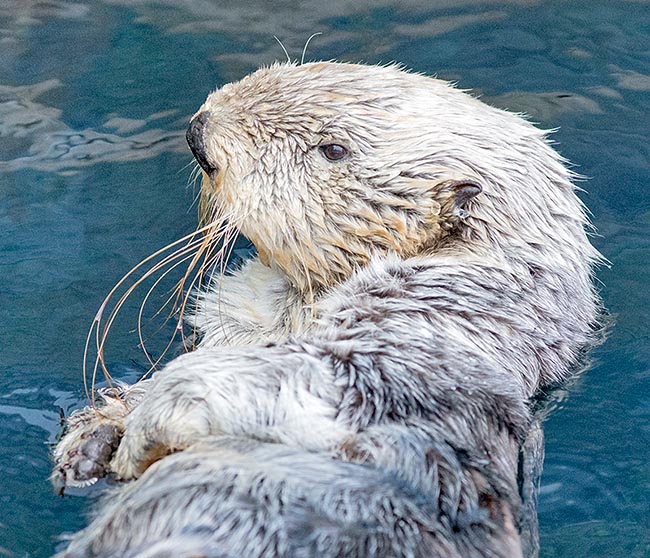
Squat head, like a marmot, and long sensitive whiskers to find the preys in the torbid waters © Giuseppe Mazza
Since the sea otter lives in the kelp forests, the preferred stretch of sea varies very much depending on the distribution of these algae that in some instances, like in some zones of Alaska, goes up to many miles off the coast. The sea otters appear to prefer habitats where the canopy of the kelp, that is the apical portion of the long fronds, reaches the surface.
Morpho-physiology
The sea otter is the heaviest among the otters and is also the one having the stockier appearance.
The Amazonic Giant otter Pteronura brasiliensis exceeds it in length but not in weight.
The males have a weight from 22 and 45 kg, with a length of 1,2-1,5 m, whilst the females, smaller, weigh 14 to 33 kg, with a length of 1-1,2 m.
The tail is responsible for about one third of the whole length. The Alaskan Northern sea otters, to be attributed to the subspecies kenyoni are slightly bigger than the Californian Southern sea otter, subspecies nereis.
Apart the size, the sexual dimorphism is quite poor.
The front limbs have retractile claws, the fingertips and the palm are glabrous and allow a good grip and a valid sense of touch. The hind feet have webbed digits and their length increases from the first to the fifth one, therefore the big toe is the shortest and the little finger is the most developed. This characteristic produces a hind feet formed like a fin, optimized for swimming.
The head is short and stocky and the muzzle has long sensitive whiskers that help in detecting the preys in torbid waters.
The eyes have a very high power of accomodation, of about 60 diopters, that renders possible a good vision in air as well as in water. Like in the night animals, the rear surface of the retina is reflective (tapetum lucidum) and not black as in the diurnal animals (tapetum nigrum).
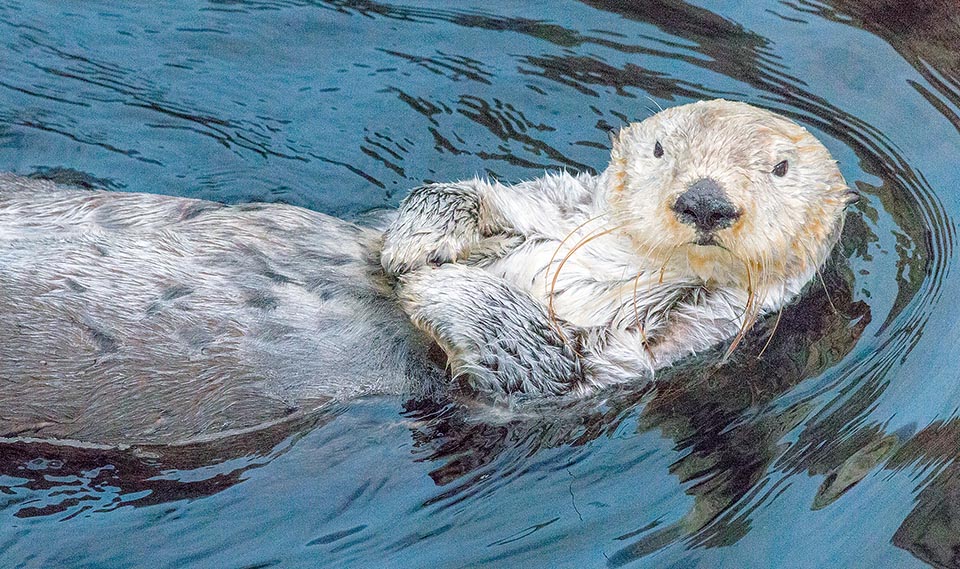
Among all mammals, Enhydra lutris is the one with the thickest fur: 100.000-400.000 hairs per sq.cm. It has 2 types of hairs, the upper ones, the guard, that stop the water, and the lowest, thick and thin, the famous wad, that trap the air with an extraordinary thermal insulation: 4 times more than equivalent fat layer © G. Mazza
This characteristic allows a high sensitivity to light, useful for the vision in poorly luminous ambients such as the underwater one, as the light rays, reflected by the tapetum lucidum return to hit the photosensitive cells of the retina practically doubling the sensitivity.
The sense of smell is little known but the turbinates are well developped, suggesting an ample surface of olfactory mucosa, and we know that the males recognize by the smell the females in oestrus and follow their trace in water.
The canines are well developped and the big molars are flattened, with rounded surfaces, suitable for crushing the shells of the crustaceans. The sea otters, unique among carnivores, have 4 inferior incisor teeth (two per side) instead of 6.
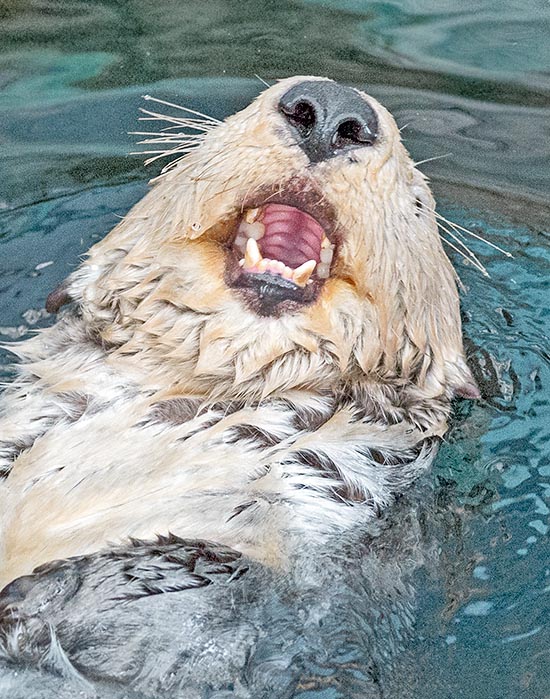
Apart the incisors, the Sea otter (Enhydra lutris) is an unusual carnivore with very strong rounded molars done for crashing the sea urchins and the hardest shells © Giuseppe Mazza
Unlike other marine mammals, in the sea otter is very scarce the subcutaneous fat and the defence against the cold is provided by the fur. This is formed by two types of hairs, the protection hairs, or guard hairs, longer and resistant, usually paler, and the lower ones of the underfur, thicker and thinner, usually darker.
The guard hairs, water-proof, protect and keep dry the lower layer that trapping the air, furnishes the thermal insulation. The thermal insulating power of this fur is very high, about four times higher than that of an equivalent layer of adipose tissue.
Among all mammals the sea otter is the one having the thicker fur: 100.000 to 400.000 hairs per square centimetre, and enormous value if we think that in the dog the hairs amount to 1000 to 9000 per square cm and in the man the hairs are 100.000 in the whole head. This helps us in understanding why the fur traders esteemed the sea otters so much!
In the skin of the sea otter are present particular sebaceous glands that secrete a fat substance that increases the water-proof power of the fur, similarly to the secretion of the gland of the uropygium (rump) of the aquatic birds.
The anal glands are absent but are, on the contrary, present in the other mustelids. The sea otters have some skinfolds at the base of the front paws that are utilized as a sort of pockets where to keep their preys or the stones they use as tools.
Closely linked to marine life and dedicated to diving, the sea otter presents a series of morpho-functional adaptations to this style of life, in some cases more evident than those of the pinnipeds and close to those of the cetaceans.
Since the sea otter spends in water most of its time, even when it eats or devotes to the care of the fur and even during the sleep or the delivery, it needs to have a great buoyancy in order not to be obliged to swim continuously for floating. This property is obtained thanks to the thick fur that traps a huge quantity of air and to a great development of the lungs, that furthermore furnish a great quantity of oxygen for the long apneas during the submarine hunting.
Another aspect that favours the long apneas comes from the high capacity of taking advantage of the anaerobic metabolism, that is to get energy from the sugars without needing oxygen. At the time of the dive a series of physiological responses is started aimed to save oxygen. Firstly occurs a slowing of the heart rhythm that from the 125 beats per minute decreases even to 10 pulsations. This allows to reduce the consumption of oxygen by the heart, leaving a greater quantity of it to the other organs.
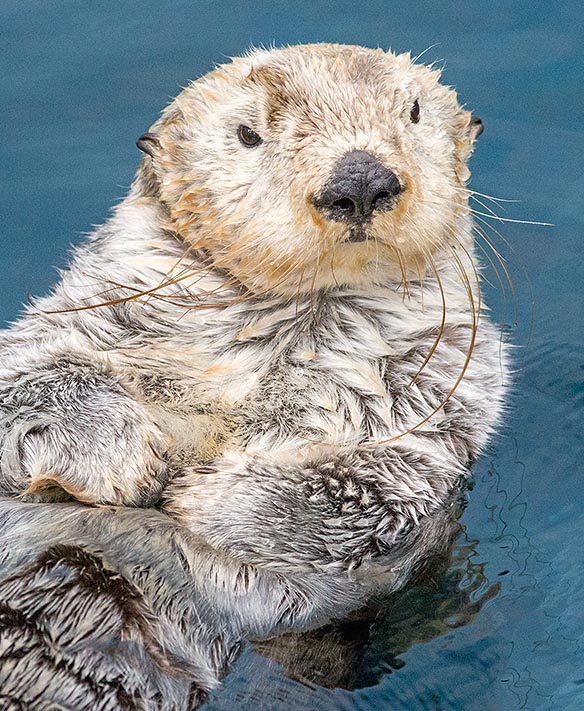
As the most evolved apes do, the otter has learnt to use tools for getting the food: in this case special stones that takes underwater in the folds of the fur. So it hammers pitiless the poor Haliotis to detach them from the rocks, breaks them, and then emerges for enjoying them in the sun © Giuseppe Mazza
Secondly, a selective vasoconstriction takes place in the peripheral parts of the body, such as the paws and the skin, leaving on the contrary more blood for the heart and the brain.
The muscles continue to be oxygenated in spite of the reduction of the blood flow thanks to their important internal reserves of oxygen. In the muscles of the sea otter, as well as of the other mammals is present a protein, the myoglobin, capable to link the oxygen and then to give it to the muscle when necessary.
Averagely, in the terrestrial mammals the concentration of the myoglobin is of 1 g/100 g muscle, whilst in the sea otter such concentration, and consequently the capacity of storing oxygen, is much higher (3 g/100 g).
In its adapting to the marine life the sea otter must also deal with the problem of the salinity: in fact it feeds on marine invertebrates that have a high contents in salts and drinks sea water with its high concentration of sodium chloride. The diet of the sea otter, furthermore, is very rich of proteins.
All this imposes the need of eliminating through the urines the exceeding salts and the waste products of the proteins metabolism, without anyway losing excessive quantities of water.
The multilobed kidney of the sea otter responds with an extraordinary capacity of concentrating the urines and therefore of saving water although eliminating the exceeding salts and the wastes. We can quantify this effectiveness by considering the concentration of solutes in the urines of the otter, that is more than the double than the sea water and five times more than the human urines.
Hence the sea otter, even if drinking sea water is able to keep the water and to eliminate the salts as well as the waste products of the metabolism.
Ethology-Reproductive Biology
Among all mammals, excepting the cetaceans and the sirens, the sea otter is the one more strictly linked to the aquatic life. Enhydra, though being able to move on the dry, spends most of its time in the water, where it hunts, sleeps, mates, delivers and breeds the pups.
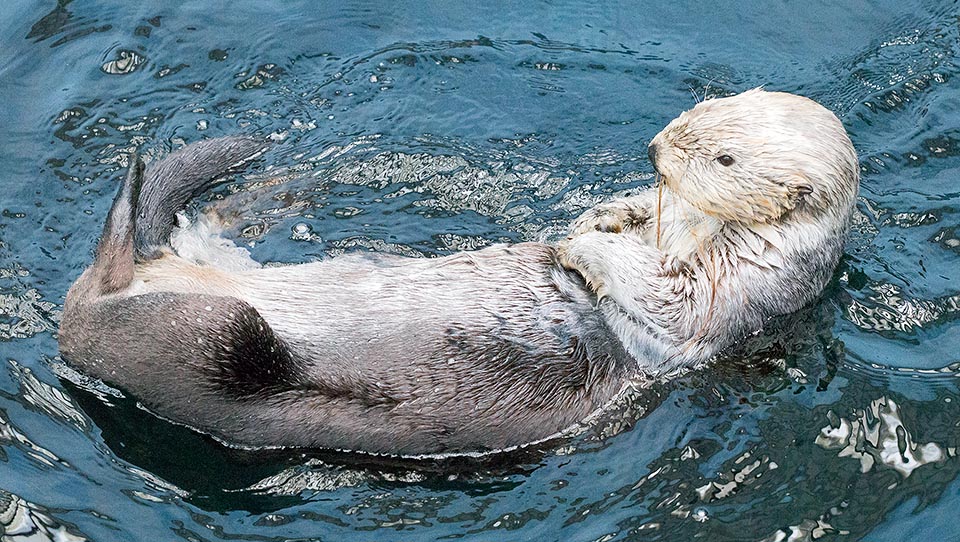
The tail serves as rudder and reaches 100 m of depth with very long apneas. To save oxygen, in immersion the heart slows the beat from 125 to 10 pulses per minute, the blood vessels narrow privileging heart and brain at the cost of the muscles that get the necessary oxygen from special reserves, triple compared to those of the common terrestrial animals. This thanks to a particular protein, the myoglobin, capable to link the oxygen and then to give it to the muscle when necessary © Giuseppe Mazza
When resting or sleeping, the sea otters float on the back, keeping the hind paws out of the water and the front ones bent on the chest or used to cover the eyes and often wrap in the fronds of the kelp to avoid being dragged by the current. When not engaged in hunting the sea otters devote diligently in caring the fur, to maintain its insulation qualities.
Even if it is a mainly diurnal hunter, the sea otter can hunt also during the night. The sea otter swims thanks to wavy dorsoventral movements of the hind part of the body and of the tail, like a seal and a dolphin, thanks to particularly mobile joints. The hind paws and the tail, besides for the propulsion, are utilized to control the direction. Even if are documented maximum dives up to 100 m, usually the sea otters go fishing at lesser depths. A dive lasts from one to four minutes, with depths of usually between the 20 and the 30 metres.
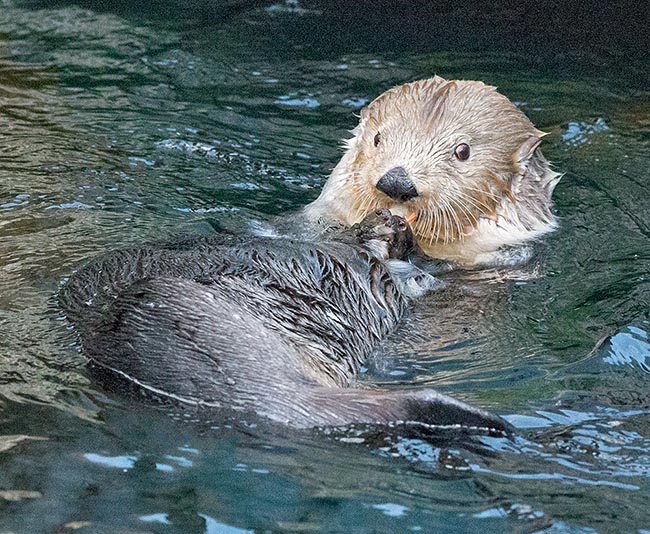
The fore paws have retractile claws and wrinkly and sensitive pads with which take the food to the mouth © Giuseppe Mazza
The preys, that are caught with the fore paws, thanks to the clawed digits and the wrinkly and sensitive fingertips, consist essentially in marine invertebrates, such as sea urchins, molluscs like in particular the rock scallops (Crassadoma gigantea, relative to the Mediterranean scallops), the mussels, the clams and the abalones or ormers (Haliotis), that are often their choice preys, but also cephalopods and crustaceans. The fishes are more rarely preyed and only exceptionally the marine birds.
The extremely powerful rounded molars render possible to break the hardest shells. To open the sea urchins the sea otter breaks the involucre on the oral side, less spiny and then licks the contents.
Possibly only case among the non primate mammals, Enhydra utilizes some tools: the sea otters in fact use stones collected from the bottom to detach the preys from the substratum as well as to break their shell. In some occurrences they slam the prey on a stone they hold on the chest and in other cases, on the contrary, they use the stone for breaking the prey they keep on the chest.
Skinfolds present between the fore legs and the thorax are utilized as pockets where to keep stones and/or preys. The same stone is often utilized for many dives. These animals have also the habit to wash the preys and do this holding the prey against the thorax and then turning over in the water.
Despite not being a social animal, the sea otter often lives in groups of some tens of individuals, however each individual hunts alone or at most in pairs, usually formed by mother and pup. Cases of thefts of preys to other couples have been observed. Conversely, during the rest we can see not structured groups more or less numerous, even of some tens of specimens floating close each other. During the period of the reproduction the male defends its own territory preventing the entrance to other males. The females, more numerous, move freely among the males’ territories. The males that do not have a private territory usually do live in groups.
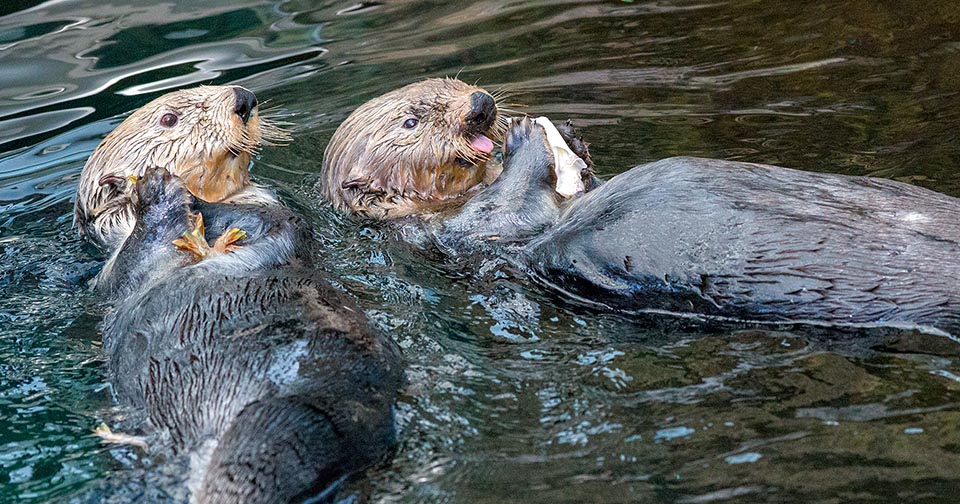
Happy couple feeding with crustaceans and a squid. Enhydra lutris is not social and the love bond lasts 3 days at most © Giuseppe Mazza
The sea otters communicate essentially through body contact and also through vocalizations, even if they are not animals particularly noisy. The most talkative are the young calling their mothers. Have been described eight different types of vocal emissions but it is not known in which situations they are emitted. Also the sense of smell has an important rôle and seems that each individual has a particular smell that informs about its identity, the sex and the reproductive physiological status. A lot of time is devoted to the accurate maintenance of the fur (grooming) cleaning, combing and aerating especially the lower layer of the thickest and thinnest hairs.
The sea otters are polygynous animals, that is, each animal mates with more females; usually the females deliver every year or at times every two.
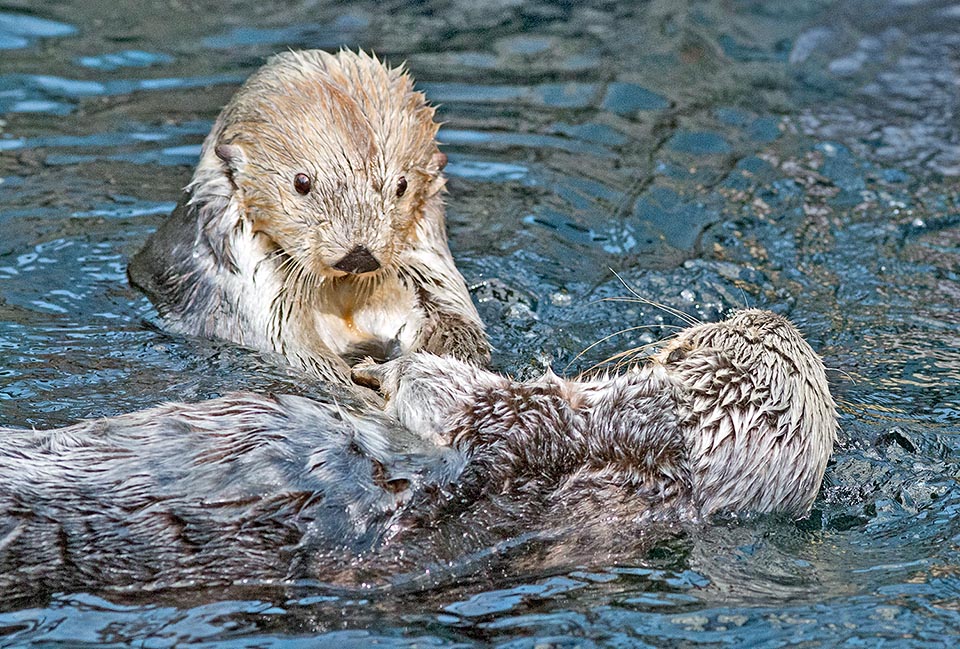
Also mating occurs in water. Found with smell a female in oestrus, immobilizes it grasping the muzzle with the jaws and completes its mission © Giuseppe Mazza
If the newborn does not survive, the mother may have a new oestrus and mate again during the same year. When a male finds a receptive female the two assume a playful and sometimes also aggressive behaviour. They stay together during the whole period of the oestrus, about three days. During the mating, that occurs in water, the male grasps with the jaws the head or the muzzle of the female. It is not rare to observe females having scars on the muzzle, memory of injuries gotten during the mating.
The pregnancy has a much variable duration, from four to twelve months. This variability of duration of the gestation is due to the fact that in the sea otters occurs the phenomenon of the delayed impantation, or embryonic diapause: after the fecundation the embryo does not implant immediately in the uterus but may stay in a dormancy status for some months. When then the implant will occur the real gestation lasts four months.
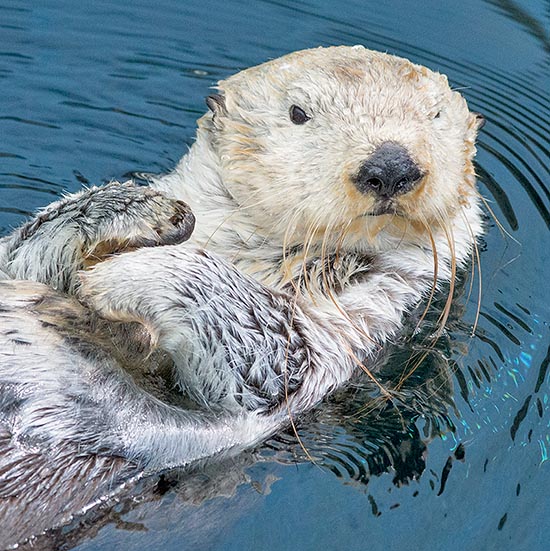
The males of Enhydra lutris do not breed the progeny. Unlike what usually happens in the carnivores world, the females of this species have only two udders © Giuseppe Mazza
This a strategy some animals adopt to avoid that the pups are born in unfavourable periods.
Also the delivery takes place in water and comes to life usually only one pup, with a weight of about 1,5-2 kg, that is not able to swim, but its fur holds as much air that allows it to float.
The males do not take part to the breeding of the progeny.
Unlike many carnivores the sea otters have only two udders. The milk has a contents of fats of the 20-25% and the pups are nursed for about 6 months, but already much before they begin to take solid food. In case of danger the females grasp the pup with the jaws and dive.
By the eighth month the young become independent and between the 3 and the 5 years they are sexually mature, the females more precociously than the males.
The average length of life is estimated in 10-12 years, with a maximum reported of 23 years.
Behaviour on the ground
Even if the sea otter spends most of its time in water, it is possible to encounter small groups of animals in the dry, usually on rocks covered by algae. It appears that the stays on the land are more frequent in winter, when the sea is very rough and occur more often in the zones less frequented by the man. The Enhydra is considered by the ecologists as a “keystone” species because its presence rules in an important way the abundance of many other species, animals as well as vegetal, therefore its protection represents an important instrument for the control of the coastal marine ecosystem.
The high daily consumption of marine invertebrates by the sea otter renders it a limiting factor of the abundance of the benthic species.A sea otter consumes daily about the 30% of its weight that, for a 25 kg animal means almost 8 kg per day. A population of 5000-8000 specimens like that of the Aleutian Islands means a consumption of about 56 tons per day! In California, in the zones frequented by the sea otters the big sea urchins are absent out from narrow crevices of the rocks where are unreachable for them, whilst they abound where the sea otters are absent.
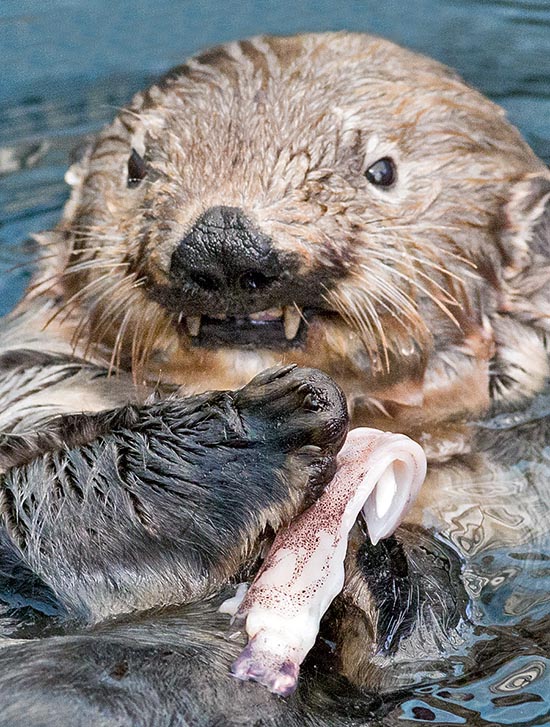
The pups are milked for 6 months, but long before they begin to assume solid food. One Enhydra consumes daily about the 30% of its weight that, for a 25 kg animal means almost 8 kg per day. Sedentary, has therefore an important habitat impact, controlling for instance the proliferation of sea urchins that menace the sea stars and the great laminarias formations © Giuseppe Mazza
Moreover, by reducing the number of the sea urchins the sea otters facilitate the development of the kelp forest that the sea urchins, proliferating, may damage.
A further positive effect is the protection agains the starfishes whose excessive proliferation is harmful for the seabeds. On the other hand, the taking of species with commercial interest such as the abalones places the otters in competition with the fishermen.
Enhidra lutris is also considered as an indicator of the health state of the marine costal ecosystem.
Being a relatively sedentary animal and at the apex of the food chain, it can store in its organism the contaminants, to which is particularly sensitive.
Nourishing mainly of filtrating invertebrates that accumulate in their tissues the toxins and the microorganisms, the sea otter is particularly damaged by many pollutants, especially those not soluble in water but present in the algae and in the sediment, and by pathogenic microorganisms. An exemplary case is that of the poisonings due to toxins of dinoflagellates.
It is known that some dinoflagellates produce extremely powerful toxins: during the “blooming” periods of these microscopic algae the filtering molluscs may accumulate strong quantities of toxins and become toxic for the man and the animals. The sea otter is strongly exposed to this risk and have occurred
widespread deaths of otters due to this phenomenon.
However, it seems that the sea otters are capable to sense the presence of the toxins and in such case they change typology of feeding and, after some observers, even reject some parts of the mollusc more loaded of toxins.
Some studies have proved that the 60% of the death rate of the sea otters in some zones is due to infective diseases linked to urban or agricultural waste.
An example is given by Toxoplasmosis, probably caused by pollution of urban waste with cat faeces, that has caused episodes of mortality in the sea otters in California. Also the protozoan Sarcocystis neurona can cause in the sea otters fatal myeloencephalitis. This protozoan is an intestinal parasite of the Opossum (Didelphis virginiana, final host), that emits the sporocysts with the faeces. The sea otters, who are one of the secondary hosts, may be infested through the faeces introduced in the waters. More common is the problem of the intestinal Acanthocephala Corynosoma of which the sea otters get infested eating infected crustaceans.
Presently Enhydra lutris is considered as an endangered species (CITES appendices Appendix I and II), no longer for hunting but for the dangers coming from the damages to the habitat, especially those linked to the oil pollution or by other sources and the net fishing. It is estimated that the accident of the VLCC Exxon Valdez of 1989, with the oilspill of 50-150.000 cubic metres of crude oil, has caused in Alaska the death of thousands of sea otters and still now the pollution of the area causes damages to the animal populations.
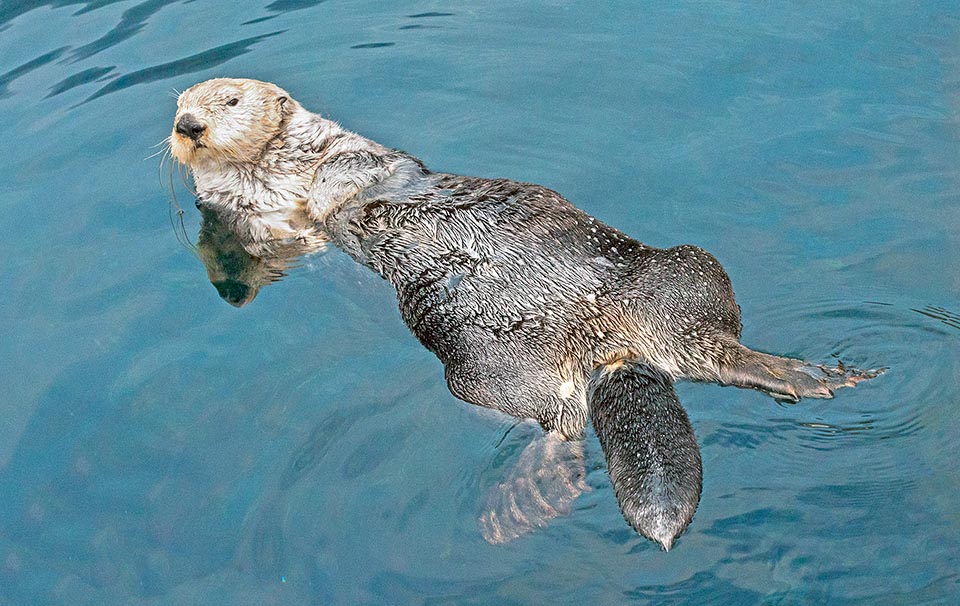
With even 45 of weight, the sea otters males exceed the Amazon giant otter that is only slightly longer © Giuseppe Mazza
The fur of the sea otter is very sensitive to the oil and other contaminants pollution, that facilitating the penetration of the water in the innermost layers of the fur can reduce its insulating capacity and cause hypothermia, pneumonia and death. Also contaminants like the tributyltin, used in the anti-fouling naval paints, insecticides like the DDT (nowadays forbidden), and PCB (polychlorinated biphenyls) have caused and still cause serious damages to this animal.
Apart from the problems of the examplified pathologies, some predators can attack the sea otters and among these we remind the killer whales, the sea lions, and especially the sharks, in particular the Great white shark (Carcharodon carcharias), that is probably the main foe of the sea otters. The young are at times predated by the Bald eagle (Haliaeetus leucocephalus). When on the land, the sea otters may be attacked by the coyotes (Canis lantrans).
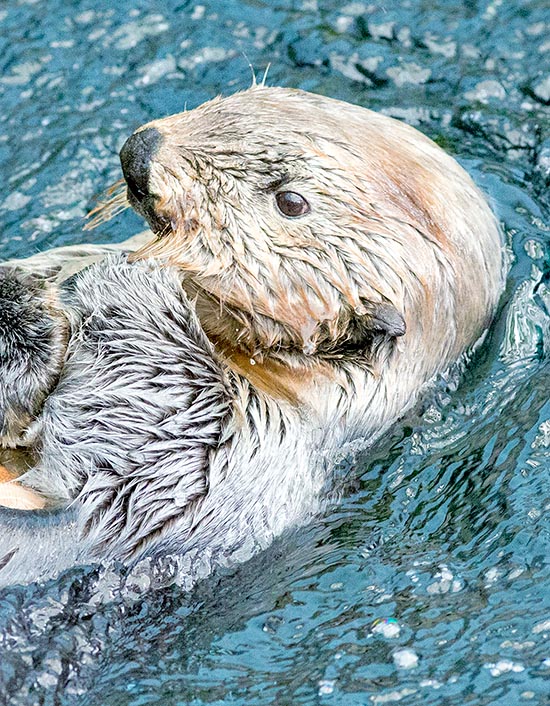
Apart cetaceans and sirenids, Enhydra lutris is the mammal more linked to water © G. Mazza
Relations with man
The sea otter was described in 1741 by Georg Steller, German physician, zoologist and explorer, membre of the expedition of Vitus Bering who, on Russia’s account, was exploring the Arctic seas. In the sinking of the ship “St. Peter” died most of the crew, among them also Bering (or, maybe, Bering died later on from scurvy). Steller was one of the survivors and in the Avacha Island, nowadays called Bering Island, where he had found refuge, he saw the first sea otters (and killed about a thousand of them).
Concerning the abundance of the sea otters and of their lack of fear towards the humans, Steller writes: “There were so many of them that we had not enough hands for killing them, whole herds covered the shore … At the beginning they were not afraid of the man, and did not move at our passage…we killed more than eight hundred of them and, should not have been so small our boat, we could have caught the triple of them”.
The man has devoted to hunt the sea otters since thousands of years, attracted by the quality of the fur but the taking for centuries has maintained modest. Since when Steller and the shipwrecked survivors of Bering’s expedition took to Russia the skins of the sea otters they had hunted and sold them at high price (10 or 20 times the cost of the precious sable), the fur traders set off the hunt that led to the slaughter of more than one million of specimens. After the Russians started the hunt the Spaniards of California and then the Americans of the coastal regions of the North-West and the Japanese.
When the species was on the brink of the extinction, Russia, Japan, United Kingdom and USA, in 1911, decided to stop the hunting. As we have seen, the vitality of the species has allowed, in the space of 150 years, to bring the numbers to values probably similar to those of a time. Despite the success of this intervention the dangers are not finished, for the previously mentioned reasons and this is proved by the fact that in various populations of Enhydra have occurred during the recent years worrying fluctuations in the number.
Besides the fur, some natives of the coasts frequented by the sea otter did hunt them for the meat. Some travelers describe its taste as loathsome (but better than that of the seals), after the explorers however many of the natives did not agree with this and ate the meats even without salt and littler cooked.
Also the shipwrecked survivors had not many prejudices about the taste and for Steller and his companions the sea otters have been the main food after the wreckage, with particular fondness for the flesh of the females and the pups.
Man represents always their main foe, also after the prohibition of hunting: accidental catching by nets and by fishing lines and wounds caused by the propellers of vessel add their effects to those of the pollution and of the destruction of the habitat.
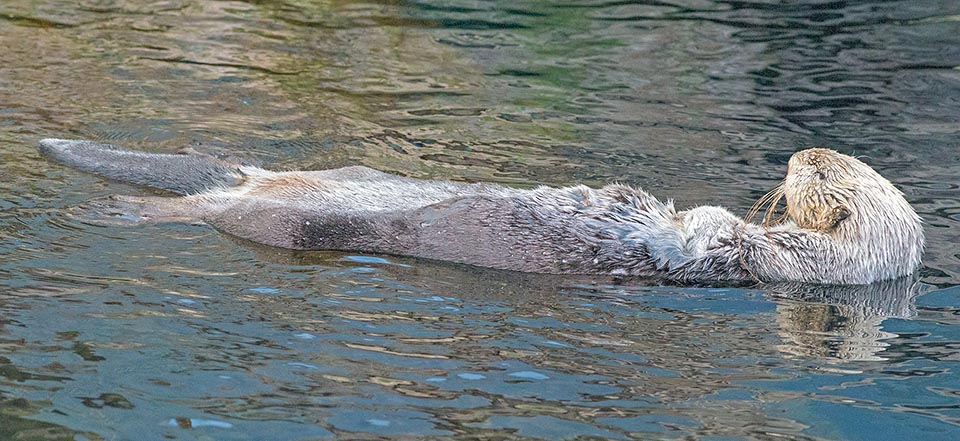
When resting or sleeping the sea otters float on the back, keeping the hind paws out of the water and the fore ones folded on the chest or on the eyes filtering the light. So as not to drift thet often grasp, as if they were anchors, the robust floating laminary algae. Man represents always their main foe, also after the prohibition of hunting © Giuseppe Mazza
The populations of the natives in contact with the sea otter have created myths and traditions linked to this animal. As an example we cite a tale of the Aleutian Islands concerning the origins of the sea otter: “Once upon a time there was a nice girl who with her brother lived in a village close to the reef, where lived the powerful Spirit of the North. One day the Spirit kidnapped the girl to marry her and she was standing all alone and scared till when, on a nice day, the brother was able to free her and take her back home. The Spirit, enraged, wanted to destroy the village and so caused a terrible storm and the inhabitants, terrified, drove out the two young. These went to seek refuge on the beach, but a huge wave dragged them into the sea. By sure they would have drowned but the Goddess of the sea, moved to pity, transformed them in two nice sea creatures, giving them, as a gift, the most wonderful fur, that would protect them against the cold even in the most frozen ocean. Thus were born the sea otters.”
Synonyms
Mustela lutris (Linnaeus, 1758), Latax lutris (Merriam, 1904).
→ To appreciate the biodiversity within MUSTELIDAE please click here.
